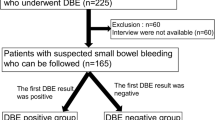Abstract
Double-balloon enteroscopy (DBE) is an effective tool for diagnosing and treating obscure gastrointestinal bleeding. The aim is to describe how outcomes differ with patient setting (with DBE diagnosis and intervention, with DBE diagnosis but without intervention, and without DBE diagnosis), and thus demonstrate the value of endoscopic intervention when encountering potential bleeder during DBE. From November 2003 to January 2008, 90 patients with obscure gastrointestinal bleeding presented with DBE at our tertiary referral center. A total of 113 DBE procedures were carried out. Overall diagnostic yield was 75.6% (68/90). Endoscopic intervention was performed in 58 (85.3%) of the 68 patients with potential bleeder. The 90 patients were divided into three settings: with endoscopic diagnosis and intervention (n = 58), with endoscopic diagnosis but without intervention (n = 10), and without endoscopic diagnosis (n = 22). Rebleeding rates for the three groups were 22.4%, 60%, and 22.7%, respectively. For the 35 patients diagnosed with vascular lesions, the rebleeding rates in patients with and without endoscopic intervention, were 38.5% (10/26) and 66.7% (6/9), respectively. One (0.9%) severe adverse event occurred during the 113 procedures, and the patient died. DBE is an effective tool for diagnosing and treating obscure gastrointestinal bleeding. DBE involves relatively safe procedures and has an acceptable complication rate. When potential bleeders are encountered during the procedure, especially for vascular lesions, therapeutic intervention should be attempted, since the intervention-related complication rate is acceptable, and such intervention can reduce the rebleeding rate and enhance the cost-effectiveness of DBE.
Similar content being viewed by others
References
Gerson LB. Double-balloon enteroscopy: the new gold standard for small bowel imaging? Gastrointest Endosc. 2005;62:71–75. doi:10.1016/S0016-5107(05)00507-9.
Rockey DC. Occult gastrointestinal bleeding. N Engl J Med. 1999;341:38–46. doi:10.1056/NEJM199907013410107.
Underhill BM. Intestinal length in man. BMJ. 1955;2:1243–1246.
Hara AK, Leighton JA, Sharma VK, Fleischer DE. Small bowel: preliminary comparison of capsule endoscopy with barium study and CT. Radiology. 2004;230:260–265. doi:10.1148/radiol.2301021535.
Costamagna G, Shah SK, Riccioni ME, et al. A prospective trial comparing small bowel radiographs and video capsule endoscopy for suspected small bowel disease. Gastroenterology. 2002;123:999–1005. doi:10.1053/gast.2002.35988.
Gutierrez C, Mariano M, Vander Laan T, Wang A, Faddis DM, Stain SC. The use of technetium-labeled erythrocyte scintigraphy in the evaluation and treatment of lower gastrointestinal hemorrhage. Am Surg. 1998;64:989–992.
Rollins ES, Picus D, Hicks ME, Darcy MD, Bower BL, Kleinhoffer MA. Angiography is useful in detecting the source of chronic gastrointestinal bleeding of obscure origin. AJR Am J Roentgenol. 1991;156:385–388.
Hayat M, Axon T, O’Mahony S. Diagnosti yield and effect on clinical outcomes of push enteroscopy in suspected small-bowel bleeding. Endoscopy. 2000;32:369–372. doi:10.1055/s-2000-9003.
Descamps C, Schmit A, Van Gossum A. Missed upper gastrointestinal tract lesions may explain occult bleeding. Endoscopy. 1999;31:452–455. doi:10.1055/s-1999-151.
Zaman A, Sheppard B, Katon RM. Total peroral intraoperative enteroscopy for obscure gastrointestinal bleeding using a dedicated push enteroscope: diagnostic yield and patient outcome. Gastrointest Endosc. 1999;50:506–510. doi:10.1016/S0016-5107(99)70073-8.
Lewis BS, Swain P. Capsule endoscopy in the evaluation of patients with suspected small intestinal bleeding: result of a pilot study. Gastrointest Endosc. 2002;56:349–353. doi:10.1016/S0016-5107(02)70037-0.
Ell C, Remke S, May A, Helou L, Henrich R, Mayer G. The first prospective controlled trial comparing wireless capsule endoscopy with push enteroscopy in chronic gastrointestinal bleeding. Endoscopy. 2002;34:865–869. doi:10.1055/s-2002-33446.
Saurin JC, Delvaux M, Gaudin JL, Fassler I, Villarejo J, Vahedi G. Diagnostic value of endoscopic capsule in patients with obscure digestive bleeding: blinded comparison with video push enteroscopy. Endoscopy. 2003;35:576–584. doi:10.1055/s-2003-38767.
Yamamoto H, Sekine Y, Sato Y, et al. Total enteroscopy with a nonsurgical steerable double-balloon method. Gastrointest Endosc. 2001;53:216–220. doi:10.1067/mge.2001.112181.
Su MY, Liu NJ, Hsu CM, Chiu CT, Chen PC, Lin CJ. Double balloon enteroscopy-the last blind-point of the gastrointestinal tract. Dig Dis Sci. 2005;56:62–70.
Hsu CM, Chiu CT, Su MY, Lin WP, Chen PC, Chen CH. The outcome assessment of double-balloon enteroscopy for diagnosing and managing patients with obscure gastrointestinal bleeding. Dig Dis Sci. 2007;62:162–166. doi:10.1007/s10620-006-9554-x.
Sun B, Rajan E, Cheng S, et al. Diagnostic yield and therapeutic impact of double-balloon enteroscopy in a large cohort of patients with obscure gastrointestinal bleeding. Am J Gastroenterol. 2006;101:2011–2015. doi:10.1111/j.1572-0241.2006.00664.x.
Yamamoto H, Kita H, Sunada K, et al. Clinical outcomes of double-balloon endoscopy for the diagnosis and treatment of small intestinal disease. Clin Gastroenterol Hepatol. 2004;2:1010–1016. doi:10.1016/S1542-3565(04)00453-7.
Manabe N, Tanaka S, Fukumoto A, Makao M, Kanimo D, Chayama K. Double-balloon enteroscopy in patients with GI bleeding. Gastrointest Endosc. 2006;64:135–140. doi:10.1016/j.gie.2005.12.020.
May A, Nachbar L, Pohl J, Ell C. Endoscopic interventions in the small bowel using double balloon enteroscopy: feasibility and limitations. Am J Gastroenterol. 2007;102:527–535. doi:10.1111/j.1572-0241.2007.01063.x.
May A, Nachbar L, Ell C. Double-balloon enteroscopy (push-and–pull enteroscopy) of the small bowel: feasibility and diagnostic and therapeutic yield in patients with suspected small bowel disease. Gastrointest Endosc. 2005;62:62–70. doi:10.1016/S0016-5107(05)01586-5.
Author information
Authors and Affiliations
Corresponding author
Rights and permissions
About this article
Cite this article
Lin, WP., Chiu, CT., Su, MY. et al. Treatment Decision for Potential Bleeders in Obscure Gastrointestinal Bleeding During Double-Balloon Enteroscopy. Dig Dis Sci 54, 2192–2197 (2009). https://doi.org/10.1007/s10620-008-0591-5
Received:
Accepted:
Published:
Issue Date:
DOI: https://doi.org/10.1007/s10620-008-0591-5




